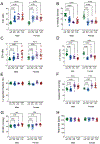Atrial Myopathy Quantified by Speckle-tracking Echocardiography in Mice
- PMID: 37795649
- PMCID: PMC10591948
- DOI: 10.1161/CIRCIMAGING.123.015735
Atrial Myopathy Quantified by Speckle-tracking Echocardiography in Mice
Abstract
Background: Emerging evidence suggests that atrial myopathy may be the underlying pathophysiology that explains adverse cardiovascular outcomes in heart failure (HF) and atrial fibrillation. Lower left atrial (LA) function (strain) is a key biomarker of atrial myopathy, but murine LA strain has not been described, thus limiting translational investigation. Therefore, the objective of this study was to characterize LA function by speckle-tracking echocardiography in mouse models of atrial myopathy.
Methods: We used 3 models of atrial myopathy in wild-type male and female C57Bl6/J mice: (1) aged 16 to 17 months, (2) Ang II (angiotensin II) infusion, and (3) high-fat diet+Nω-nitro-L-arginine methyl ester (HF with preserved ejection fraction, HFpEF). LA reservoir, conduit, and contractile strain were measured using speckle-tracking echocardiography from a modified parasternal long-axis window. Left ventricular systolic and diastolic function, and global longitudinal strain were also measured. Transesophageal rapid atrial pacing was used to induce atrial fibrillation.
Results: LA reservoir, conduit, and contractile strain were significantly reduced in aged, Ang II and HFpEF mice compared with young controls. There were no sex-based interactions. Left ventricular diastolic function and global longitudinal strain were lower in aged, Ang II and HFpEF, but left ventricular ejection fraction was unchanged. Atrial fibrillation inducibility was low in young mice (5%), moderately higher in aged mice (20%), and high in Ang II (75%) and HFpEF (83%) mice.
Conclusions: Using speckle-tracking echocardiography, we observed reduced LA function in established mouse models of atrial myopathy with concurrent atrial fibrillation inducibility, thus providing the field with a timely and clinically relevant platform for understanding the pathophysiology and discovery of novel treatment targets for atrial myopathy.
Keywords: aging; atrial fibrillation; cardiomyopathies; echocardiography; heart failure; mice.
Conflict of interest statement
Figures





Comment in
-
Opportunities and Challenges of Murine Atrial Strain Imaging.Circ Cardiovasc Imaging. 2023 Oct;16(10):e015976. doi: 10.1161/CIRCIMAGING.123.015976. Epub 2023 Oct 5. Circ Cardiovasc Imaging. 2023. PMID: 37795598 No abstract available.
References
-
- Goette A, Kalman JM, Aguinaga L, Akar J, Cabrera JA, Chen SA, Chugh SS, Corradi D, D'Avila A, Dobrev D, et al. EHRA/HRS/APHRS/SOLAECE expert consensus on atrial cardiomyopathies: Definition, characterization, and clinical implication. Heart Rhythm. 2017;14:e3–e40. doi: 10.1016/j.hrthm.2016.05.028 - DOI - PMC - PubMed
Publication types
MeSH terms
Grants and funding
LinkOut - more resources
Full Text Sources
Medical
Research Materials
Miscellaneous

